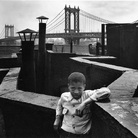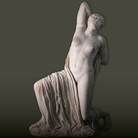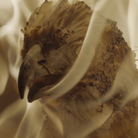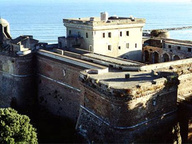Armando Testa. Punto e Basta

Opera di Armando Testa
Dal 18 April 2018 al 1 June 2018
Milano
Luogo: Galleria Lia Rumma
Indirizzo: via Stilicone 19
Orari: martedì-sabato ore 11-13.30 / 14.30-19
Telefono per informazioni: +39.02.29000101
E-Mail info: info@liarumma.it
Sito ufficiale: http://www.liarumma.it
La Galleria Lia Rumma è lieta di presentare la personale di Armando Testa, dal titolo “punto e basta”.
Armando Testa è stato uno dei più grandi creativi italiani, protagonista della cultura visiva contemporanea, creatore di simboli entrati a far parte del nostro immaginario collettivo. L’artista ha esplorato molteplici linguaggi riuscendo a creare capolavori senza tempo, la cui modernità è oggi fonte di ispirazione per gli artisti contemporanei. Con le sue opere ha dimostrato una profonda conoscenza dei processi semiotici e visivi che stanno alla base del nostro sistema comunicativo, generando attraverso le sue immagini doppi sensi e nuovi signifcati.
Frutto di un’approfondita ricerca d’archivio, la mostra presenta disegni, serigrafe e fotografe, ma anche dipinti, sculture e opere di design con l’obiettivo di esplorare gli aspetti concettuali dell’opera di Testa, sottolineando come le sue intuizioni comunicative spesso fossero il frutto di un processo creativo che partiva dall’arte, per poi trasformarsi e creare immagini capaci di cogliere i cambiamenti in atto e un futuro non ancora visibile a tutti.
Un esempio perfetto di questo processo è la scultura Uno e mezzo (1960) presente nella prima sala espositiva: quello che tutti noi conosciamo come Punt e Mes, immagine legata al logo del famoso vermouth Carpano, nasceva in realtà come scultura minimalista alla metà degli anni Cinquanta, composta da un'essenziale sfera e mezza.
Ad accompagnare l’opera, nella prima sala, sono allestite anche una serie di lavori che fondono l’interesse di Armando Testa per l’arte e per il design.
Su una parete sono infatti esposte una serie di opere realizzate in laminato, con la sovrapposizione di ricercate cornici d’epoca che sottolineano la valenza pittorica delle opere stesse, un omaggio dichiarato al grande Piet Mondrian. Ricordano quelle utilizzate per incastonare antichi specchi sostituiti dai quadri realizzati con linee perpendicolari e campiture di colore geometriche, di colori primari, assieme al bianco e al nero, come se Testa ci indicasse che invece di specchiare noi stessi, dovremmo aspirare alla continua ricerca di equilibrio e perfezione formale che Mondrian aveva intuito nella sua arte.
Di fronte ad ognuno di questi quadri è collocata la famosissima Sedia AT (1990), realizzata utilizzando la forma delle sue iniziali negli elementi essenziali: la seduta (a forma di A) e la spalliera (a forma di T). Queste sedie hanno un valore performativo, Testa si è ispirato ad una situazione reale, probabilmente una delle tante conferenze a cui partecipava, in cui il relatore di turno risultava noioso. Per questo ha ipotizzato una sala piena di queste sedie e il pubblico, se stesso compreso, che ad un certo momento si siede a cavalcioni, con le braccia e il capo sulla T in modo da fare, nei momenti più critici del congresso, una solenne russata.
Queste sedie, come da sua indicazione, sono allestite in mostra come se mimassero gli inginocchiatoi delle chiese, per esprimere ancora di più il desiderio di specchiamento e al tempo stesso di contemplazione delle forme geometriche delle opere ispirate a Mondrian.
Completano la sala altre tre opere. Una sedia-matita in cui una delle gambe è rappresentata da una matita che trafgge la seduta, creando un precario equilibrio. L’oggetto simboleggia l’idea dell’odio e amore verso la sua professione: martirio del corpo perché costretto su una sedia per diverse ore, ma allo stesso tempo, gioia della mente che crea.
Accanto, è presentato l’Armadio Y (1971) che rappresenta nel nostro immaginario e nel suo utilizzo, uno degli elementi identitari di una persona. Testa pensa di decorarlo con una grande lettera dell’alfabeto in rilievo: l’accostamento di lettere diverse si presta alla creazione di messaggi personali. Le opere sono accompagnate dalla Sedia Antropomorfa (1976) la quale contiene in sé l’idea dell’oggetto e della persona.
Al primo piano il tema dominante è rappresentato dalle mani e in particolare dalle dita. Quella per le dita era una vera e propria ossessione per Testa, che utilizzerà spesso come iconografa delle sue opere, come nella composita serie di disegni, acquarelli e piccoli dipinti esposta su una delle pareti della galleria e realizzati a partire dagli anni Sessanta; così com’è nella serie di foto allestita nella parete opposta. La scelta allestitiva deriva dalla volontà di sottolineare come l’immagine delle mani e delle dita abbracci idealmente il resto delle opere qui esposte come espressamente testimoniato dalla serie di sculture di ceramica Mani, realizzate tra il 1969 e il 1987 e, in modo più sottile, nella scultura dell’Aquila meccanica (1977), il cui realismo è stravolto dall’inserimento dell’occhio meccanico e dal colore destabilizzante della vernice industriale che ricopre le piume dell’uccello regale, che rappresentano, ancora una volta a sottolineare l'importanza del ruolo e delle iconografa delle mani, le impronte digitali dell’artista.
Infne al secondo piano, il percorso espositivo si completa con alcune realizzazioni tra le più conosciute e famose, nate a partire dalla fne degli anni Cinquanta: animali e personaggi fantastici che hanno origine spesso da giochi di accostamenti tra il linguaggio Pop dei soggetti e il Surrealismo dei materiali utilizzati. Si accostano a queste opere sculture, dedicate al tema del cibo, concepite a partire dagli anni Sessanta. Sono visibili in mostra: Michetta energetica(1968), Tavolo riservato con scarpine (1980), Stallone Sylvestre (1986), Spadaccini infammati (1987) e Nocero umbro (1991).
Nella stessa sala è allestita l’opera Omaggio a Armando Testa (1995) che Haim Steinbach gli ha dedicato e che presenta alcune icone del lavoro pubblicitario di Armando, accostate ad un oggetto quotidiano. Papalla, Caballero e Carmencitarappresentano una dimensione narrativa, più conosciuta al grande pubblico, a cui si fonde una sfera più personale e intima simboleggiata dal personaggio del ranocchio.
Chiude la mostra la Lampadina limone, geniale invenzione del 1968, emblema e simbolo dell’energia creativa di Armando Testa ammantata dalla sua ironia.
SCARICA IL COMUNICATO IN PDF
COMMENTI

-
 Dal 2 December 2025 al 19 February 2026
Milano | Centro Culturale di Milano
Dal 2 December 2025 al 19 February 2026
Milano | Centro Culturale di Milano
Walter Rosenblum. Il mondo e la tenerezza
-
 Dal 30 November 2025 al 12 April 2026
Gallarate | Museo MA*GA
Dal 30 November 2025 al 12 April 2026
Gallarate | Museo MA*GA
Kandinsky e l’Italia
-
 Dal 29 November 2025 al 12 April 2026
Roma | Musei Capitolini
Dal 29 November 2025 al 12 April 2026
Roma | Musei Capitolini
La Grecia a Roma
-
 Dal 22 November 2025 al 3 May 2026
Torino | Sale Chiablese dei Musei Reali
Dal 22 November 2025 al 3 May 2026
Torino | Sale Chiablese dei Musei Reali
Orazio Gentileschi. Un pittore in viaggio
-
 Dal 20 November 2025 al 25 January 2026
Firenze | Palazzo Strozzi
Dal 20 November 2025 al 25 January 2026
Firenze | Palazzo Strozzi
Andro Eradze. Bones of Tomorrow
-
 Dal 21 November 2025 al 28 March 2026
Cuneo | Complesso Monumentale di San Francesco
Dal 21 November 2025 al 28 March 2026
Cuneo | Complesso Monumentale di San Francesco
La Galleria Borghese. Da Raffaello a Bernini. Storia di una collezione


